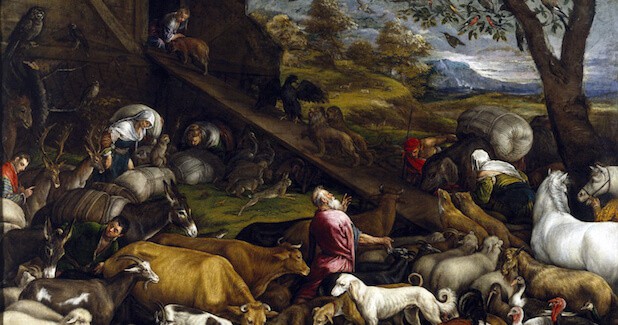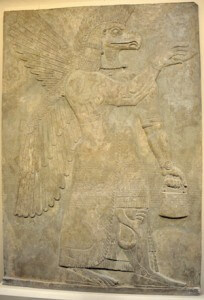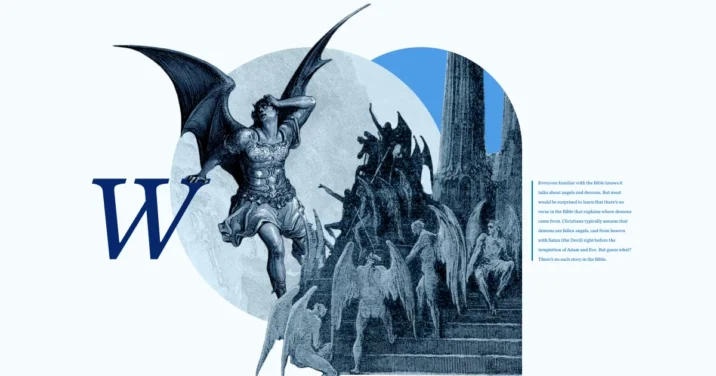Everyone familiar with the Bible knows it talks about angels and demons. But most would be surprised to learn that there’s no verse in the Bible that explains where demons came from. Christians typically assume that demons are fallen angels, cast from heaven with Satan (the Devil) right before the temptation of Adam and Eve. But guess what? There’s no such story in the Bible. The only description of anything like that is in Revelation 12:9—but the occasion for that whole episode was the birth of the Messiah (Rev 12:4–6), an event long after Adam and Eve. The idea of a primeval fall of angels actually comes from church tradition and the great English poet John Milton in his epic Paradise Lost.
So if the Bible doesn’t record an ancient expulsion from heaven by hordes of angels who then became known as demons, where do demons come from?
There’s actually a straightforward answer to that question, but it’s likely one you’ve never heard of: In ancient Jewish texts like the Dead Sea Scrolls, demons are the disembodied spirits of dead Nephilim giants who perished at the time of the great flood.
I know what you’re thinking—Mike, you’re trying to freak us out because it’s Halloween season. I’ll admit this is great fodder for Halloween, but I’m serious about that being the answer. I’ll briefly sketch the idea below, but if you want all the serious data and high-browed scholarship behind it, you’ll have to read my book, The Unseen Realm: Recovering the Supernatural Worldview of the Bible.
While I referenced the Dead Sea Scrolls above, don’t be misled. This explanation for the origin of demons has secure links in the biblical text, they just aren’t obvious—to us anyway. To an ancient reader, someone who lived during the time of the Bible, this explanation would have been quite clear. For us to see what they saw, we need to go back to the Bible’s account of the great flood.
The sons of God, the Nephilim, and the Mesopotamian Apkallu

The first four verses of the Bible’s flood account read:
When man began to multiply on the face of the land and daughters were born to them, the sons of God saw that the daughters of man were attractive. And they took as their wives any they chose. Then the Lord said, ‘My Spirit shall not abide in man forever, for he is flesh: his days shall be 120 years.’ The Nephilim were on the earth in those days, and also afterward, when the sons of God came in to the daughters of man and they bore children to them. These were the mighty men who were of old, the men of renown. (Gen 6:1–4, ESV)
The sons of God—angels in more familiar parlance—transgress the divinely-ordained boundary between heaven and earth by producing children with human women. Those children are referred to as Nephilim. The term “Nephilim” doesn’t mean “fallen ones”; it means “giants.” Those who want to read the scholarly data behind that conclusion can read The Unseen Realm. For our purposes, what we need to focus on is that scholars of ancient cuneiform—the wedge-writing on clay tablets known from ancient Mesopotamia—have recently uncovered new evidence in those tablets that provide clear, explicit parallels to Genesis 6:1–4 that validate what I’m presenting—and explain why this weird story was included in the flood story.

In Mesopotamian religion, divine beings known as apkallu are a central focus of the Mesopotamian version of the flood story. The apkallu were dispensers of divine knowledge to humanity. They get credited with teaching the people of Mesopotamia what they needed to know to establish human civilization. When the great gods decided humans were too noisy and irritating and needed to be wiped out, the apkallu came up with a plan to preserve the divine knowledge humanity would need—they fathered children with human woman. Sure enough, the plan worked, as the quasi-divine humans who survived the flood—also known as apkallu—rebuilt civilization. They were the mighty ones whose wisdom and exploits led to the greatness of cities like Babylon. These “second generation apkallu” were not only divine-human hybrids, but they were also described as giants in the Mesopotamian epics. Gilgamesh is perhaps the most familiar example. He is called “lord of the apkallu” in a cuneiform inscription on a small clay seal.
Let’s not miss the point. Each element of the biblical story—the divine beings who cohabit with human women and produce giant offspring—are represented in the Mesopotamian story. Both the divine fathers and their giant children are called apkallu in the cuneiform sources. Incidentally, statues of the apkallu have been discovered by archaeologists in boxes in the foundations of walls for protection against evil spirits. The boxed apkallu are referred to by another Mesopotamian term: mats-tsarey, which means “watchers.”
While that’s interesting (and bizarre), you might ask what that has to do with demons. The answer is theology.
The “Anakim, who are counted as Rephaim” (Deut 2:11)
Genesis 6:1–4 was written by Israelites who wanted to make a statement: the apkallu before the flood were not good guys. What they did was wicked, and the giant offspring apkallu produced by their transgression were enemies of the true God of heaven. In fact, their own giant offspring were bent on annihilating Israel many years later.
Later in biblical history, during the days of Moses and Joshua, the Israelites ran into groups of very large warriors called Anakim. Numbers 13:32–33 tells us explicitly that the Anakim came from the Nephilim. The giant clans went by other names as well: Emim, Zamzummim, and Rephaim (Deut 2–3). The wars of conquest for the land required the annihilation of these giant Anakim, which is why Joshua summed up the conquest this way: “There was none of the Anakim left in the land of the people of Israel. Only in Gaza, in Gath, and in Ashdod did some remain.” Those were three Philistine cities. Goliath would come from one of them (Gath) in the days of David (1 Sam 17:4).
The key to understanding how these giants were perceived as demons in the biblical material—an idea that got a lot of focus in Jewish writings produced after the Old Testament—is the term Rephaim. In the Old Testament, the Rephaim are described as giant warlords (Deut 2:8–11; 3:1–11; Josh 13:12), but also as frightening, sinister disembodied spirits (“the shades”) in the Underworld, called Sheol in Hebrew (Isa 14:9; 26:14; Job 26:5). The disembodied spirits of these giants were therefore associated with the abode of the dead, something everyone feared, since everyone feared death.
But the Rephaim also had another awful association. There are nearly 10 references in the Old Testament to a place called the Valley of the Rephaim (e.g., 2 Sam 5:18, 22; 23:13). Joshua 15:8 and 18:16 tell us that the Valley of the Rephaim adjoined another valley—the Valley of Hinnom, also known as the Valley of the Son of Hinnom. In Hebrew “Valley of Hinnom” is ge hinnom, a phrase from which the name gehenna derives—a term conceptually linked to Hades/Hell in the New Testament.
Tying the threads together
While this supernatural backdrop has eluded most Christian thinkers in the history of Christianity to the present day, it was well known to the generation of Jews who lived right after the Old Testament period—what scholars call the “Second Temple” period or, more popularly, the “Intertestamental” period. It was during this era that books like 1 Enoch were written, as well as the Dead Sea Scrolls.
In the book of 1 Enoch the villainous sons of God of Genesis 6:1–4 are not only called angels—they are called Watchers. The link back to the Mesopotamian apkallu is transparent and unmistakable. First Enoch spells out how the Watchers and their offspring were the source of demons:
In those days, when the children of man had multiplied, it happened that there were born unto them handsome and beautiful daughters. And the angels, the children of heaven, saw them and desired them; and they said to one another, ‘Come, let us choose wives for ourselves from among the daughters of man and beget us children.’ . . . And they took wives unto themselves, and everyone (respectively) chose one woman for himself, and they began to go unto them. . . .
Then Michael, Surafel, and Gabriel observed carefully from the sky and they saw much blood being shed upon the earth, and all the oppression being wrought upon the earth. . . . As for the women, they gave birth to giants to the degree that the whole earth was filled with blood and oppression. And now behold, the Holy One will cry, and those who have died will bring their suit up to the gate of heaven. Their groaning has ascended (into heaven), but they could not get out from before the face of the oppression that is being wrought on earth. . . . And to Gabriel the Lord said, ‘Proceed against the bastards and the reprobates and against the children of adultery; and destroy the children of adultery and expel the children of the Watchers from among the people. And send them against one another (so that) they may be destroyed in the fight, for length of days have they not. . . .’
And when they and all their children have battled with each other, and when they have seen the destruction of their beloved ones, bind them for 70 generations underneath the rocks of the ground until the day of their judgment and of their consummation, until the eternal judgment is concluded. . . . But now the giants who are born from the (union of) the spirits and the flesh shall be called evil spirits upon the earth, because their dwelling shall be upon the earth and inside the earth. Evil spirits have come out of their bodies. Because from the day that they were created from the holy ones they became the Watchers; their first origin is the spiritual foundation. They will become evil upon the earth and shall be called evil spirits.
—1 Enoch 6:1-2; 7:1; 9:1, 9-10; 10:9; 15:8-91
1 Enoch calls the giants “bastard spirits”—a phrase used of demons in several Dead Sea Scrolls.
A non-biblical psalm found among the Dead Sea Scrolls calls demons “offspring of man and the seed of the holy ones,” a clear reference to the disembodied spirits of the divine-human offspring from Genesis 6:1–4.2
Books by the author
The Unseen Realm: Recovering the Supernatural Worldview of the Bible
Regular price: $17.99

The World Turned Upside Down: Finding the Gospel in Stranger Things
Regular price: $8.99

Supernatural: What the Bible Teaches about the Unseen World—And Why It Matters
Regular price:






